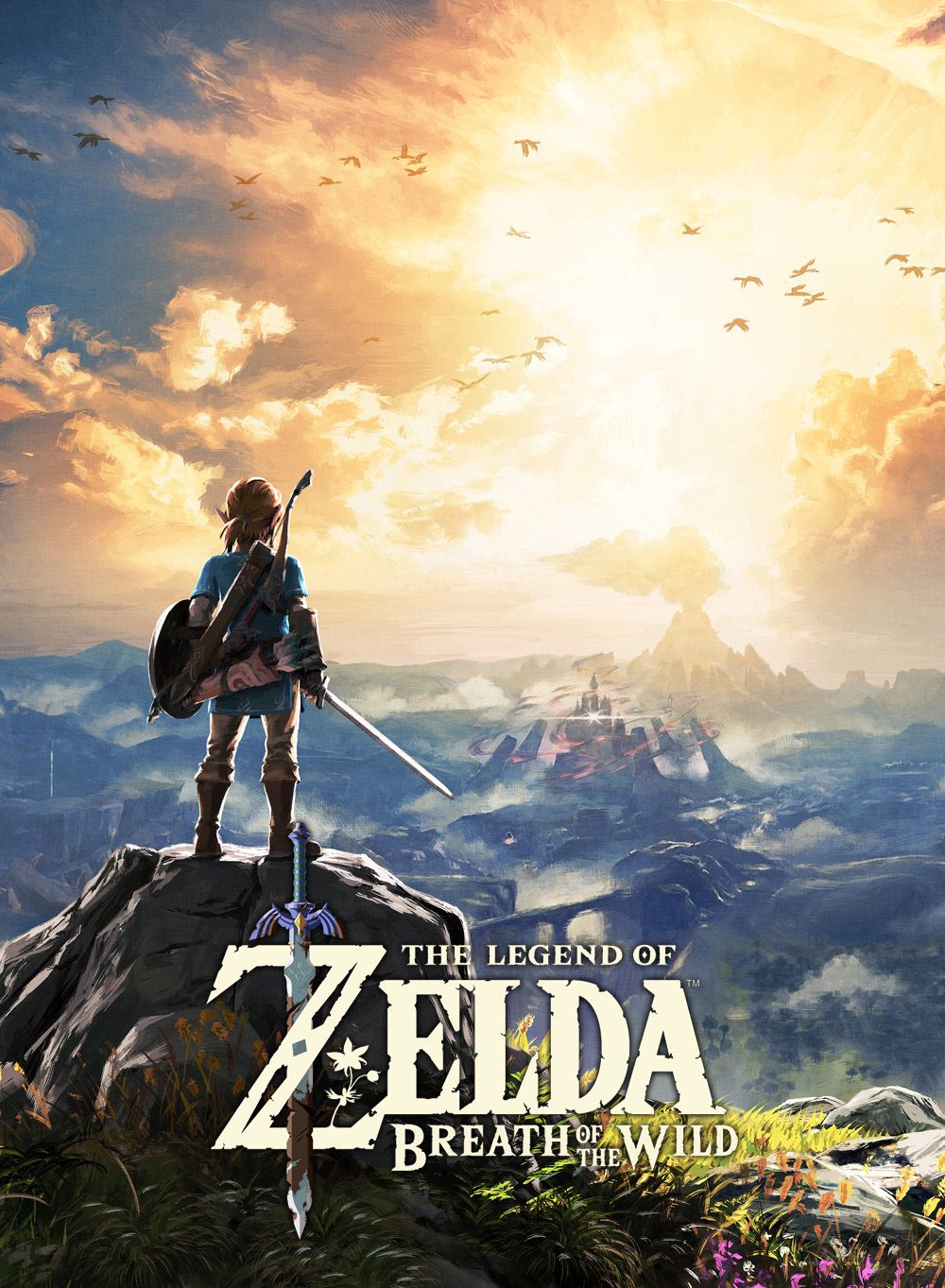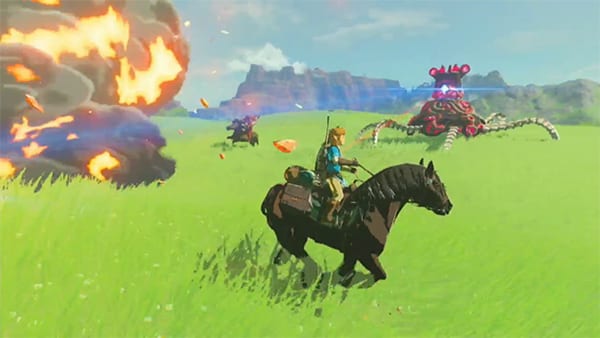So I’ve come to The Legend of Zelda: Breath of the Wild from a slightly odd angle. Whilst most reviewers are enjoying it on Nintendo’s brand spanking new system, the Switch, I picked my copy for the long struggling Wii U. The Wii U’s shortcomings have been listed by dozens of articles in the past couple of years, so I won't be getting into them here. Because Zelda is much better than arguments about the pros and cons of a console. For Zelda always seems to transcend the trend of modern gaming and is quite happy to remain in its own unique groove. So with Breath of the Wild, Nintendo is going out of its comfort zone slightly by taking influence from Western RPGs, such as Skyrim and The Witcher 3 to produce the first truly open-world Zelda game since arguably the original. Does this mix work?
(As a side note, I have been playing the game with a Pro Controller).
I would describe Breath of the Wild as the oddest 3D console Zelda game. It's not odd in the sense of, say, Majora’s Mask (my all-time favourite game by-the-by), which is thematically and tonally odd. Breath of the Wild is odd in that it's the first one to really shake that Link To The Past/Ocarina of Time structure away that has clung to the series for decades. Now, I love the traditional Zelda structure – for me, it's the way Nintendo presents each entry visually and how they use the structure in different ways that makes the series one of my favourites. But I would be lying if I said I wasn't up for a change in the formula. Breath of the Wild takes away many familiar elements and re-jigs them into an incredibly satisfying game that, while I have a few niggles, manages to evoke that childlike sense of wonder and exploration. You'll be doing the traditional Zelda things but the new structure will get you thinking about the untapped possibilities of the series.
From the start of the game, we are thrown off balance. Link is awakened by a mysterious voice in a strange pool bed. Link is awarded a Sheikah Tablet, a futuristic device in which the player can view the map, keep track of missions and maintain the inventory. Soon we venture outside to take in Hyrule, a vast vista of green grass and old ruins in full HD glory, with both Hyrule Castle and Death Mountain looming ominously in the background. And we are immediately thrust into the adventure. You are free to explore this vast environment and you soon begin to discover the key differences with this Zelda game. I would argue Breath of the Wild has the best tutorial section in any game I have played, in that it lets you discover the rules and objectives of the game without major prompts. Zelda games are often held back by their lengthy tutorials (Twilight Princess being the number one culprit). Here, Breath of the Wild lets you discover the rules and the story. For Link has awoken 100 years into the future after an evil being known as Calamity Ganon successfully defeated the Hylian kingdom and now looms menacingly as a corporal form around Hyrule Castle. The only thing holding him in place is the continued efforts of the elusive Princess Zelda, trapped in a century long struggle to control the evil from spreading further. Before the defeat of Hyrule, the kingdom was at the height of its technological prowess having invented mechanical beings known as Guardians, who are now scattered across the landscape either defeated with growing moss surrounding them, or as corrupted agents of Ganon. The world is now a unique blend of medieval Japan and Europe style with some sci-fi elements. Think Shadow of the Colossus meets Laputa: Castle In The Sky. For that former game’s sense of loneliness is beautifully evoked in the opening hours of the game before we venture into what is left of Hyrule’s population. Hyrule feels like a real, breathing place for really first time in the series (where it once was a hub to connect the different areas together). Upon completion of the excellent tutorial section, the map opens to us and we are encouraged to go where we want. There are markers and mission objectives (like in Skyrim) but how we go about it is our choice. There is no Navi equivalent in this game! The ultimate goal is awaken the four mythical beasts to help the player in defeating Ganon and freeing Zelda. The order these objectives can be completed in is up to you.
As you begin to fight enemies, you learn that they drop their weapons upon being defeated (similar to The Wind Waker). Soon you have an arsenal of varied weapons to take on Ganon’s minions. This includes one-handed swords, broadswords, lances, spears, Soul Calibur-esque mega-swords, Guardian weaponry and a bow (which is awarded very early on for a Zelda game). The controls can be a bit tricky at first but swapping and changing between melee weapons and the bow becomes very natural. However, after several fights, weapons can (and will) break. Weapon durability becomes a big part of your strategising and adds an interesting new tactical (and sometimes frustrating) element to the game. This is one of the only elements of the game I have mixed feelings about. While I understand that later game weapons get stronger and stronger, as better weapons are afforded to us (with the Master Sword apparently being unbreakable, naturally), that sense of progression, often key to an RPG, is taken away slightly. It's hard to know when to use your best weapons in battles for fear of them breaking. There are repair elements to the game but this comes later on. Now that aside, the satisfaction of Link wielding multiple different weapons gives a new sense to each battle. While the battle system has been simplified somewhat from the complex motion controls of Skyward Sword, Breath of the Wild makes up for it in the variety of different encounters and styles of battle.
As we begin to venture into the cold high mountains or into smouldering hot locations in search of the next objective, Link begins to suffer from the extreme drops or rise in temperature. Clearly, we need something to assist Link here. This is where the game’s infinitely deep cooking system comes into play. By collecting plants, meat and monster parts, Link can concoct meals that restore health and temporarily improve stats and elixirs that give special status effects (again temporarily) that include resistance to heat, cold and improve speed. The game actively encourages you to seek out as many ingredients as possible and experiment with the cooking mechanic. These stat boosts are often essential for when you are trying to traverse difficult areas. This adds a brilliant one layer to exploration and offers a genuine risk. The best thing the game does is give you the tools needed to complete the game upfront – it will be challenging but possible.
The art design of Breath of the Wild is unparalleled. The game is further proof that good art design always wins. The once-hated, now-loved cel-shade style is back and arguably better than ever. The bright colours and dark hues are rendered beautifully in HD. Everything is rendered in extreme detail, from the small flowers in the fields to the variety of different weapons Link can wield to the dusty buildings of old villages to the excellent weather system that truly emphasises both the danger and beauty of exploration. The vastness and detail of the game is overwhelming. Alongside the main quest, the world is filled with dozens of side quest and collectibles to keep you playing long after the credits have rolled That said, the game does suffer from frame rate issues (both on the Wii U and the Switch). This mostly seems to happen when fire is involved or, oddly, in the opening areas. Now this is quite rare and is only mildly distracting when it occurs.
With a few niggles aside, Breath of the Wild is a stunning game. While Nintendo might struggle to stay relevant in the modern gaming industry, it does know how to make great games. It's a beautiful blend of excellent controls, gorgeous art design and smart structuring. Nintendo has managed to bring a sense of awe back to the series with its surprising turns and great sense of discovery. Some technical issues can take you out briefly but the overall experience is not to be missed. This entry is the closest in spirit to the original game. With little prompts, the secret weapon of Zelda’s success is at the forefront – exploration. Breath of the Wild, whether you play it on the Wii U or on the Switch, is unmissable. Whether you’re soaring over Hyrule with your paraglider or rushing across the wilderness astride your trusty stead or taking it one step at a time, Breath of the Wild takes the best elements of all previously Zelda games and puts an addictive new spin on the formula that emphasises freedom and exploration. The game design brilliantly weaves this in from the opening minutes. A brilliant swansong for the ailing Wii U and a shining beacon of hope for the Switch.
Where can the series go from here?






No comments:
Post a Comment